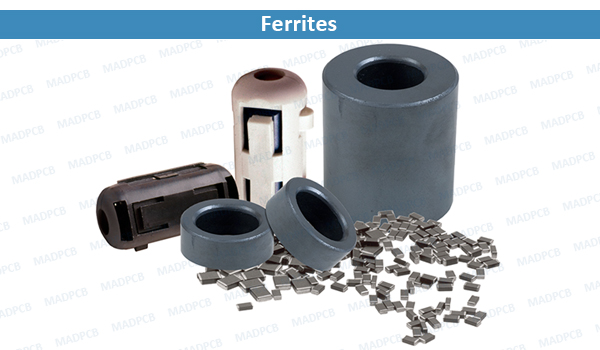What are Ferrites?
Ferrites are usually ferrimagnetic ceramic compounds derived from iron oxides. Magnetic (Fe3Q4) is famous example. Like most of the other ceramics, ferrites are hard, brittle, and poor conductors of electricity.

Ferrites
Many ferrites adopt the spinel structure with the formula AB2O4, where A and B represent various metal cations, usually including iron (Fe). Spinel ferrites usually adopt a crystal motif consisting of cubic close-packed (fcc) oxides (O2−) with A cations occupying one eighth of the tetrahedral holes and B cations occupying half of the octahedral holes.
Ferrite crystals do not adopt the ordinary spinel structure, but rather the inverse spinel structure: One eighth of the tetrahedral holes are occupied by B cations, one fourth of the octahedral sites are occupied by A cations. and the other one fourth by B cation. It is also possible to have mixed structure spinel ferrites.
The magnetic material known as “ZnFe” has the formula ZnFe2O4, with Fe3+ occupying the octahedral sites and Zn2+ occupy the tetrahedral sites, it is an example of normal structure spinel ferrite.
Some ferrites adopt hexagonal crystal structure, like barium and strontium ferrites BaFe12O19 (BaO:6Fe2O3) and SrFe12O19 (SrO:6Fe2O3).
In terms of their magnetic properties, the different ferrites are often classified as “soft”, “semi-hard” or “hard”, which refers to their low or high magnetic coercivity, as follows.
Where to Use?
In PCB assembly, SMT fabricators always meet ferrite bead. When designing electronic equipment, controlling the EMI (electromagnetic interference) in a device is necessary to protect components, and often external equipment, from damage caused by high frequency noise levels.
Ferrite cores are used in electronic inductors, transformers, and electromagnets where the high electrical resistance of the ferrite leads to very low eddy current losses.
Ferrites are also found as a lump in a computer cable, called a ferrite bead, which helps to prevent high frequency electrical noise (radio frequency interference) from exiting or entering the equipment; these types of ferrites are made with lossy materials to not just block (reflect), but also absorb and dissipate as heat, the unwanted higher-frequency energy.
Early computer memories stored data in the residual magnetic fields of hard ferrite cores, which were assembled into arrays of core memory. Ferrite powders are used in the coatings of magnetic recording tapes.
Ferrite particles are also used as a component of radar-absorbing materials or coatings used in stealth aircraft and in the absorption tiles lining the rooms used for electromagnetic compatibility measurements. Most common audio magnets, including those used in loudspeakers and electromagnetic instrument pickups, are ferrite magnets. Except for certain “vintage” products, ferrite magnets have largely displaced the more expensive Alnico magnets in these applications. In particular, for hard hexaferrites today the most common uses are still as permanent magnets in refrigerator seal gaskets, microphones and loud speakers, small motors for cordless appliances and in automobile applications.
Ferrite nanoparticles exhibit superparamagnetic properties.
